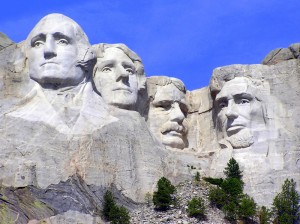 Earlier this week we celebrated President’s Day. I don’t know how many Americans took time out of their day off to ponder the achievements of Washington, Lincoln, Harrison, or Polk. But the U.S. Department of the Interior did.
Earlier this week we celebrated President’s Day. I don’t know how many Americans took time out of their day off to ponder the achievements of Washington, Lincoln, Harrison, or Polk. But the U.S. Department of the Interior did.
Interior put up a website on the legacies of “Eight presidents who shaped America’s public lands,” which might have been a worthwhile educational effort but for the bizarre selection chosen. Thomas Jefferson, for instance, is cited because the Louisiana Purchase doubled America’s size. But Jefferson had no plan to add to “America’s public lands.” He would be appalled at how much land is still federally owned, and at the very existence of the Interior Department, BLM, Fish and Wildlife Service, and EPA. Perhaps we feel more enlightened today, but to cite him as a great hero of public lands just proves someone at Interior hasn’t read his writings.
The obvious first choice was Theodore Roosevelt, who started the modern conservation movement and laid the foundations for today’s national forests, wildlife refuges, and reclamation projects that made the desserts bloom. The website mentions the little-known facts that Abraham Lincoln was the first President to set aside beautiful places for preservation (Yosemite), and that Ulysses Grant created the first national park (Yellowstone).
That ends Interior’s discussion of any contributions of Republicans to the conservation cause, maybe because those three all served over a century ago. It is ironic, though, because the conservation movement was created, and nurtured for 150 years, by Republicans – though also helped along by Democrats like Woodrow Wilson and Franklin Roosevelt (Wilson created Rocky Mountain National Park, and Roosevelt created the Civilian Conservation Corps).
You see, for 100 years or so, conservation was not partisan. Not that every political leader always agreed, but leaders of both parties generally supported preserving treasures like the Grand Canyon and the national forests, and efforts to clean up the air and water. Local leaders often petitioned Congress to set aside special places, to preserve them for future generations, and to swell local pride – and tourism dollars. That is how most of Colorado’s national park lands were created, including Colorado National Monument, Dinosaur, Black Canyon, Great Sand Dunes, and Mesa Verde.
Those campaigns, uniting local governments, chambers of commerce, newspaper editors, and tourism bureaus, are not mentioned on the Interior website – because that is not the way most such lands are set aside in today’s partisan climate. So it is beyond ironic that Interior chose to ignore the existence of Richard Nixon. I know how politically incorrect Nixon is, but it can hardly be denied that he created the EPA, and signed into law more environmental laws than any other President: the Endangered Species Act, Clean Air Act, Clean Water Act, Safe Drinking Water Act, Ocean Dumping Act, and others – all of which earned bipartisan support in a Democratic Congress.
Instead, Interior included Jimmy Carter, who “had a massive impact on public lands,” especially with the Alaska Lands Act, which set aside over 100 million acres in ten national parks, two monuments, nine wildlife refuges, two conservation areas and 25 wild and scenic rivers. Carter’s inclusion on this list is peculiar because it was his use of executive orders that changed these issues from bi-partisan to bitterly divisive. He was the first President to use that authority to set aside national monuments, not only without the intense lobbying by local communities that had always preceded such designations, but over the strong objections of the residents and their elected officials. Precisely because the congressional delegation from Alaska opposed these measures, Carter simply used executive authority to do it anyway.
President Bill Clinton did the same thing with several eleventh-hour executive orders, worsening the sectional bitterness that pervades conservation politics in the West today. Environmental issues have never been bi-partisan since, and that is tragic, for civil political dialog, and for the environment.
The use of executive power to “protect” great places (from the locals) will be used extensively by President Obama on his way out the door – count on it. Clinton didn’t make Interior’s list of the top eight, but Obama did. Perhaps political appointees can be forgiven for using such an auspicious list to highlight the activities of the boss who appointed them, though featuring Obama on the “hit parade” of greatest Presidents in this category may call their objectivity into question. He has changed over 200 million acres from multiple-use to national monuments, but whether history will remember that positively remains to be seen.
I would rather highlight Presidents Taft, Wilson, Harding, Coolidge, FDR, Truman, Eisenhower, and Kennedy – all of whom responded to requests from unified communities and states to protect and preserve majestic places for future Americans, in a bipartisan and collaborative manner.
(A version of this column originally appeared in the Grand Junction Daily Sentinel February 19, 2016)




Comments on this entry are closed.